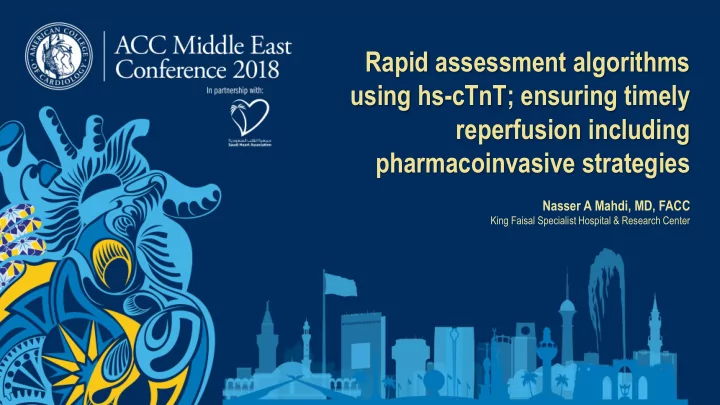

Rapid assessment algorithms using hs-cTnT; ensuring timely reperfusion including pharmacoinvasive strategies Nasser A Mahdi, MD, FACC King Faisal Specialist Hospital & Research Center
Rapid assessment algorithms using hs-cTnT • About 20 million patients present with symptoms suggestive of myocardial infarction (MI) to ED Demographics, traditional risk factors, chest pain characteristics, and physical examination can assist but are • insufficient who does and does not have MI The early diagnosis of MI is crucial for the early initiation of evidence-based treatment • 20% of AMI & 40% of UA have normal EKG in emergency room • • Only about one in four of those with significant ST depression prove to have ACS
MI with Non-diagnostic EKG EKG often does not detect:- Transient myocardial ischemia. Ischemia in patients with prior MI. Vein graft occlusion.
4 MI with Non-diagnostic EKG • Ronan 1989 (AJC), Slaler 1987 (AJC) 3 – 10% • Singer 1997 (Ann Emerg Med) 17% Forest 2004 (Ann Emerg Med) 2% • Chase M 2006 (Acta Emerg Med) 2.8% • Samuel D 2009 (Acta Emerg Med) 7% •
Myocardial Necrosis Markers Troponins Troponin T exhibits a dual release initially of the cytoplasmic component and later of • the bound component. • Troponin I is extremely specific for the cardiac muscle and has not been isolated from the skeletal muscle. This absolute specificity makes it an ideal marker of myocardial injury. • They are released into the circulation 6-8 h after myocardial injury, peak at 12-24 h • and remain elevated for 7 – 10 days. Only disadvantage of cTn is the late clearance that makes it difficult to identify a recurrent myocardial infarction.
MI with Non-diagnostic EKG EKG should be obtained within 10 minutes of arrival of patient in ED. • EKG should be repeated at 20 – 30 minute intervals for any patient with ongoing chest pain in high suspicion • case. • Serial EKG equally specific (95%) but more sensitive than an initial single EKG for detecting acute MI (68 Vs 55%). • If the standard leads are inconclusive, additional leads to be obtained. V3R, V4R, V6,7,8, 9, high lateral leads. • Computer assisted ST-T monitoring.
Sensitive & High Sensitivity Cardiac Troponin Assays • Detection of cTn in • ~ 20 -50% of healthy individuals (sensitive) ~ 50-70% of healthy individuals (high sensitivity) • Normal = the 99th percentile • • cTn value above the 99 percentile of a normal reference population is a ‘condition sine que non’ for diagnosis of AMI
Clinical implications of high-sensitivity cardiac troponin assays Compared with standard cardiac Troponin assays, high sensitivity assays: Have higher negative predictive value for acute MI. • Reduce the “troponin - blind” interval leading to earlier detection of acute MI . • • Result in a ~4% absolute and ~20% relative increases in the detection of type I MI and a corresponding decrease in the diagnosis of unstable angina. Are associated with a 2-fold increase in the detection of type 2 MI. •
Rapid Rule-out & Rule-in Protocol Excellent performance of 2 hrs rule-out protocol that combines hs-cTn value with clinical • information. • Also 1 hr rule-out & rule-in protocol based on hs-cTnT values. • There is immense diagnostic value of interpreting hs-cTn concentration as quantitative value.
The use of sensitive or high-sensitivity cardiac troponin [(h)s-cTn] allows more rapid rule-out and more rapid rule-in.
0 h / 3 h rule-out algorithm of non-ST elevation acute coronary syndrome using high-sensitivity cardiac troponin assays
0 h / 1 h rule-out algorithm of non-ST elevation acute coronary syndrome using high-sensitivity cardiac troponin assays
Thank You
Recommend
More recommend